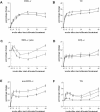Nevirapine and efavirenz elicit different changes in lipid profiles in antiretroviral-therapy-naive patients infected with HIV-1
- PMID: 15526045
- PMCID: PMC523838
- DOI: 10.1371/journal.pmed.0010019
Nevirapine and efavirenz elicit different changes in lipid profiles in antiretroviral-therapy-naive patients infected with HIV-1
Erratum in
- PLoS Med. 2004 Dec;1(3):e73
Abstract
Background: Patients infected with HIV-1 initiating antiretroviral therapy (ART) containing a non-nucleoside reverse transcriptase inhibitor (NNRTI) show presumably fewer atherogenic lipid changes than those initiating most ARTs containing a protease inhibitor. We analysed whether lipid changes differed between the two most commonly used NNRTIs, nevirapine (NVP) and efavirenz (EFV).
Methods and findings: Prospective analysis of lipids and lipoproteins was performed in patients enrolled in the NVP and EFV treatment groups of the 2NN study who remained on allocated treatment during 48 wk of follow-up. Patients were allocated to NVP (n = 417), or EFV (n = 289) in combination with stavudine and lamivudine. The primary endpoint was percentage change over 48 wk in high-density lipoprotein cholesterol (HDL-c), total cholesterol (TC), TC:HDL-c ratio, non-HDL-c, low-density lipoprotein cholesterol, and triglycerides. The increase of HDL-c was significantly larger for patients receiving NVP (42.5%) than for patients receiving EFV (33.7%; p = 0.036), while the increase in TC was lower (26.9% and 31.1%, respectively; p = 0.073), resulting in a decrease of the TC:HDL-c ratio for patients receiving NVP (-4.1%) and an increase for patients receiving EFV (+5.9%; p < 0.001). The increase of non-HDL-c was smaller for patients receiving NVP (24.7%) than for patients receiving EFV (33.6%; p = 0.007), as were the increases of triglycerides (20.1% and 49.0%, respectively; p < 0.001) and low-density lipoprotein cholesterol (35.0% and 40.0%, respectively; p = 0.378). These differences remained, or even increased, after adjusting for changes in HIV-1 RNA and CD4+ cell levels, indicating an effect of the drugs on lipids over and above that which may be explained by suppression of HIV-1 infection. The increases in HDL-c were of the same order of magnitude as those seen with the use of the investigational HDL-c-increasing drugs.
Conclusion: NVP-containing ART shows larger increases in HDL-c and decreases in TC:HDL-c ratio than an EFV-containing regimen. Based on these findings, protease-inhibitor-sparing regimens based on non-nucleoside reverse transcriptase inhibitor, particularly those containing NVP, may be expected to result in a reduced risk of coronary heart disease.
Conflict of interest statement
JMAL is a member of the editorial board of
Figures
References
-
- Manninen V, Elo MO, Frick MH, Haapa K, Heinonen OP, et al. Lipid alterations and decline in the incidence of coronary heart disease in the Helsinki Heart Study. JAMA. 1988;260:641–651. - PubMed
-
- Rubins HB, Robins SJ, Collins D, Fye CL, Anderson JW, et al. Gemfibrozil for the secondary prevention of coronary heart disease in men with low levels of high-density lipoprotein cholesterol. Veterans Affairs High-Density Lipoprotein Cholesterol Intervention Trial Study Group. N Engl J Med. 1999;341:410–418. - PubMed
-
- Nissen SE, Tsunoda T, Tuzcu EM, Schoenhagen P, Cooper CJ, et al. Effect of recombinant ApoA-I Milano on coronary atherosclerosis in patients with acute coronary syndromes: A randomized controlled trial. JAMA. 2003;290:2292–2300. - PubMed
-
- Bisoendial RJ, Hovingh GK, Levels JH, Lerch PG, Andresen I, et al. Restoration of endothelial function by increasing high-density lipoprotein in subjects with isolated low high-density lipoprotein. Circulation. 2003;107:2944–2948. - PubMed
-
- Brewer HB Jr. High-density lipoproteins: A new potential therapeutic target for the prevention of cardiovascular disease. Arterioscler Thromb Vasc Biol. 2004;24:387–391. - PubMed
Publication types
MeSH terms
Substances
LinkOut - more resources
Full Text Sources
Medical
Research Materials


